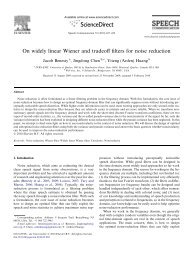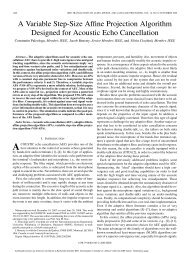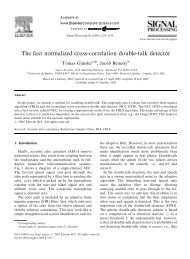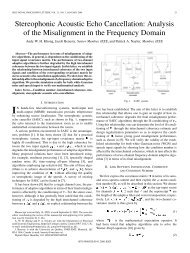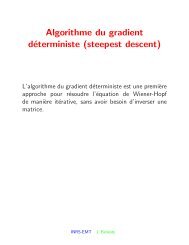A Generalized MVDR Spectrum - ResearchGate
A Generalized MVDR Spectrum - ResearchGate
A Generalized MVDR Spectrum - ResearchGate
You also want an ePaper? Increase the reach of your titles
YUMPU automatically turns print PDFs into web optimized ePapers that Google loves.
IEEE SIGNAL PROCESSING LETTERS, VOL. 12, NO. 12, DECEMBER 2005 827<br />
A <strong>Generalized</strong> <strong>MVDR</strong> <strong>Spectrum</strong><br />
Jacob Benesty, Senior Member, IEEE, Jingdong Chen, Member, IEEE, and Yiteng (Arden) Huang, Member, IEEE<br />
Abstract—The minimum variance distortionless response<br />
(<strong>MVDR</strong>) approach is very popular in array processing. It is also<br />
employed in spectral estimation where the Fourier matrix is used<br />
in the optimization process. First, we give a general form of the<br />
<strong>MVDR</strong> where any unitary matrix can be used to estimate the<br />
spectrum. Second and most importantly, we show how the <strong>MVDR</strong><br />
method can be used to estimate the magnitude squared coherence<br />
function, which is very useful in so many applications but so few<br />
methods exist to estimate it. Simulations show that our algorithm<br />
gives much more reliable results than the one based on the popular<br />
Welch’s method.<br />
Index Terms—Capon, coherence function, cross-spectrum, minimum<br />
variance distortionless response (<strong>MVDR</strong>), periodogram,<br />
spectral estimation, spectrum.<br />
I. INTRODUCTION<br />
SPECTRAL estimation is a very important topic in signal<br />
processing, and applications demanding it are countless<br />
[1]–[3]. There are basically two broad categories of techniques<br />
for spectral estimation. One is the nonparametric approach,<br />
which is based on the concept of bandpass filtering. The other<br />
is the parametric method, which assumes a model for the<br />
data, and the spectral estimation then becomes a problem of<br />
estimating the parameters in the assumed model. If the model<br />
fits the data well, the latter may yield a more accurate spectral<br />
estimate than the former. However, in the case that the model<br />
does not satisfy the data, the parametric model will suffer significant<br />
performance degradation and lead to a biased estimate.<br />
Therefore, a great deal of research efforts are still devoted to<br />
the nonparametric approaches.<br />
One of the most well-known nonparametric spectral estimation<br />
algorithms is the Capon’s approach, which is also known<br />
as minimum variance distortionless response (<strong>MVDR</strong>) [4], [5].<br />
This technique was extensively studied in the literature and is<br />
considered as a high-resolution method. The <strong>MVDR</strong> spectrum<br />
can be viewed as the output of a bank of filters, with each filter<br />
centered at one of the analysis frequencies. Its bandpass filters<br />
are both data and frequency dependent, which is the main difference<br />
with a periodogram-based approach where its bandpass<br />
filters are a discrete Fourier matrix, which is both data and frequency<br />
independent [3], [6].<br />
The objective of this letter is twofold. First, we generalize the<br />
concept of the <strong>MVDR</strong> spectrum. Second and most importantly,<br />
Manuscript received June 2, 2005; revised July 14, 2005. The associate editor<br />
coordinating the review of this manuscript and approving it for publication was<br />
Dr. Hakan Johansson.<br />
J. Benesty is with the Université du Québec, INRS-EMT, Montréal, QC,<br />
H5A 1K6, Canada (e-mail: benesty@emt.inrs.ca).<br />
J. Chen and Y. Huang are with Bell Laboratories, Lucent Technologies,<br />
Murray Hill, NJ 07974 USA (e-mail: jingdong@research.bell-labs.com;<br />
arden@research.bell-labs.com).<br />
Digital Object Identifier 10.1109/LSP.2005.859517<br />
we show how to use this approach to estimate the magnitude<br />
squared coherence (MSC) function as an alternative to the popular<br />
Welch’s method [7].<br />
Let<br />
input of<br />
II. GENERAL FORM OF THE SPECTRUM<br />
be a zero-mean stationary random process that is the<br />
filters of length<br />
where superscript denotes transposition.<br />
If we denote by the output signal of the filter , its<br />
power is<br />
where is the mathematical expectation, superscript denotes<br />
transpose conjugate of a vector or a matrix<br />
is the covariance matrix of the input signal<br />
In the rest of this letter, we always assume that<br />
definite.<br />
Consider the unitary matrix<br />
, and<br />
(1)<br />
(2)<br />
is positive<br />
with<br />
. In the proposed generalized <strong>MVDR</strong><br />
method, the filter coefficients are chosen so as to minimize the<br />
variance of the filter output, subject to the constraint<br />
Under this constraint, the process is passed through the<br />
filter with no distortion along and signals along other<br />
vectors than tend to be attenuated. Mathematically, this is<br />
equivalent to minimizing the following cost function:<br />
where is a Lagrange multiplier. The minimization of (4) leads<br />
to the following solution:<br />
We define the spectrum of along as<br />
(3)<br />
(4)<br />
(5)<br />
(6)<br />
1070-9908/$20.00 © 2005 IEEE
828 IEEE SIGNAL PROCESSING LETTERS, VOL. 12, NO. 12, DECEMBER 2005<br />
Therefore, plugging (5) into (6), we find that<br />
(7)<br />
The first obvious choice for the unitary matrix<br />
Fourier matrix<br />
is the<br />
Expression (7) is a general definition of the spectrum of the<br />
signal , which depends on the unitary matrix . Replacing<br />
the previous equation in (5), we get<br />
where<br />
Taking into account all vectors<br />
the general form<br />
where<br />
(8)<br />
, (8) has<br />
(9)<br />
and . Of course, is a<br />
unitary matrix. With this choice, we obtain the classical Capon’s<br />
method.<br />
Now suppose . In this case, a Toeplitz matrix is<br />
asymptotically equivalent to a circulant matrix if its elements<br />
are absolutely summable [8], which is usually the case in most<br />
applications. Hence, we can decompose as<br />
(12)<br />
and<br />
diag<br />
is a diagonal matrix.<br />
Property 1: We have<br />
(10)<br />
Proof: This form follows immediately from (9).<br />
Property 1 shows that there are an infinite number of ways<br />
to decompose matrix , depending on how we choose the<br />
unitary matrix . Each one of these decompositions gives a<br />
representation of the square of the spectrum of the signal<br />
in the subspace .<br />
Property 2: We have<br />
Proof: Indeed<br />
tr<br />
tr tr (11)<br />
tr<br />
Property 2 expresses the energy conservation. So no matter<br />
what we take for the unitary matrix , the sum of all values of<br />
the inverse spectrum is always the same.<br />
A. Particular Cases<br />
In this subsection, we propose to briefly discuss three important<br />
particular cases of the general form of the <strong>MVDR</strong> spectrum.<br />
tr<br />
tr<br />
so that . As a result, for a stationary signal and asymptotically,<br />
Capon’s approach is equivalent to the periodogram. The<br />
difference between the <strong>MVDR</strong> and periodogram approaches can<br />
also be viewed as the difference between the eigenvalue decompositions<br />
of circulant and Toeplitz matrices. While for a circulant<br />
matrix, its corresponding unitary matrix is data independent,<br />
it is not for a Toeplitz matrix.<br />
The second natural choice for is the matrix containing the<br />
eigenvectors of the correlation matrix . Indeed, it is well<br />
known that can be diagonalized as follows [9]:<br />
(13)<br />
where is a unitary matrix containing the eigenvectors , and<br />
is a diagonal matrix containing the corresponding eigenvalues<br />
. Thus, taking ,wefind that and<br />
(14)<br />
In many applications, the process signal is real, and it<br />
may be more convenient to select an orthogonal matrix instead<br />
of a unitary one. So our third and final particular case is the<br />
discrete cosine transform<br />
where the rest is shown in the equation at the bottom of the<br />
page, with and for .We<br />
can verify that<br />
. So with this orthogonal<br />
transform, the spectrum is<br />
diag (15)
BENESTY et al.: GENERALIZED <strong>MVDR</strong> SPECTRUM 829<br />
III. APPLICATION TO THE CROSS-SPECTRUM<br />
AND MSC FUNCTION<br />
In this section, we show how to use the generalized <strong>MVDR</strong><br />
approach for the estimation of the cross-spectrum and the MSC<br />
function.<br />
A. General Form of the Cross-<strong>Spectrum</strong><br />
We assume here that we have two zero-mean stationary<br />
random signals and with respective spectra<br />
and . As explained in Section II, we can<br />
design two filters<br />
For (23) to have the true sense of the cross-spectrum definition,<br />
the matrix should be complex (and unitary).<br />
Property 3: We have<br />
tr<br />
(24)<br />
Proof: This is easy to see from (23).<br />
Property 3 is similar to property 2 and shows another form of<br />
energy conservation.<br />
to find the spectra of and along<br />
where<br />
(16)<br />
(17)<br />
B. General Form of the MSC Function<br />
We define the MSC function between two signals and<br />
as<br />
(25)<br />
From (23), we deduce the magnitude squared cross-spectrum<br />
(26)<br />
is the covariance matrix of the signal<br />
and<br />
(18)<br />
Using expressions (17) and (26) in (25), the MSC becomes<br />
(27)<br />
Property 4: We have<br />
Let and be the respective outputs of the filters<br />
and .Wedefine the cross-spectrum between and<br />
along as<br />
(19)<br />
(28)<br />
Proof: Since matrices and are assumed to<br />
be positive definite, it is clear that<br />
. To prove that<br />
, we need to rewrite the MSC function. Define<br />
the vectors<br />
where the superscript<br />
Similarly<br />
is the complex conjugate operator.<br />
and the normalized cross-correlation matrix<br />
(29)<br />
(30)<br />
(20)<br />
Using the previous definitions in (27), the MSC is now<br />
Now if we develop (19), we get<br />
where<br />
(21)<br />
(22)<br />
is the cross-correlation matrix between and . Replacing<br />
(16) in (21), we obtain the cross-spectrum<br />
(23)<br />
Consider the Hermitian positive semidefinite matrix<br />
and the vectors<br />
(31)<br />
(32)<br />
(33)<br />
(34)
830 IEEE SIGNAL PROCESSING LETTERS, VOL. 12, NO. 12, DECEMBER 2005<br />
We can easily check that<br />
(35)<br />
(36)<br />
Inserting these expressions in the Cauchy–Schwartz inequality<br />
(37)<br />
we see that .<br />
Property 4 was, of course, expected in order that the definition<br />
(27) of the MSC could have a sense.<br />
C. Simulation Example<br />
In this subsection, we compare the MSC function estimated<br />
with our approach and with the MATLAB function “cohere”<br />
that uses the Welch’s averaged periodogram method [7]. We<br />
consider the illustrative example of two signals and<br />
that do not have that much in common, except for two sinusoids<br />
at frequencies and<br />
(38)<br />
(39)<br />
where and are two independent zero-mean (real)<br />
white Gaussian random processes with unit variance. The<br />
phases and in the signal are random. In this<br />
example, the theoretical coherence should be equal to at<br />
the two frequencies and and at the others. Here we<br />
chose and . For both algorithms, we<br />
took 1024 samples and a window of length . As for<br />
the choice of the unitary matrix in our approach, we took the<br />
Fourier matrix. Fig. 1(a) and (b) give the MSC estimated with<br />
MATLAB and our method, respectively. Clearly, the estimation<br />
of the coherence function with our algorithm is much closer to<br />
its theoretical values.<br />
IV. CONCLUSION<br />
The <strong>MVDR</strong> principle is very popular in array processing<br />
and spectral estimation. In this letter, we have shown that this<br />
concept can be generalized to unitary matrices other than the<br />
Fig. 1.<br />
Estimation of the MSC function. (a) MATLAB function “cohere.” (b)<br />
Proposed algorithm with U = F. Conditions of simulations: K =100and a<br />
number of samples of 1024.<br />
Fourier transform for spectrum evaluation. Most importantly,<br />
we have given an alternative to the popular Welch’s method for<br />
the estimation of the MSC function. Simulations show that the<br />
new method works much better.<br />
REFERENCES<br />
[1] S. L. Marple, Jr., Digital Spectral Analysis with Applications. Englewood<br />
Cliffs, NJ: Prentice-Hall, 1987.<br />
[2] S. M. Kay, Modern Spectral Estimation: Theory and Application. Englewood<br />
Cliffs, NJ: Prentice-Hall, 1988.<br />
[3] P. Stoica and R. L. Moses, Introduction to Spectral Analysis. Upper<br />
Saddle River, NJ: Prentice-Hall, 1997.<br />
[4] J. Capon, “High resolution frequency-wavenumber spectrum analysis,”<br />
Proc. IEEE, vol. 57, no. 8, pp. 1408–1418, Aug. 1969.<br />
[5] R. T. Lacoss, “Data adaptive spectral analysis methods,” Geophys., vol.<br />
36, pp. 661–675, Aug. 1971.<br />
[6] P. Stoica, A. Jakobsson, and J. Li, “Matched-filter bank interpretation<br />
of some spectral estimators,” Signal Process., vol. 66, pp. 45–59, Apr.<br />
1998.<br />
[7] P. D. Welch, “The use of fast Fourier transform for the estimation of<br />
power spectra: A method based on time averaging over short, modified<br />
periodograms,” IEEE Trans. Audio Electroacoust., vol. AU-15, no. 2,<br />
pp. 70–73, Jun. 1967.<br />
[8] R. M. Gray, “Toeplitz and Circulant Matrices: A Review,” Stanford<br />
Univ., Stanford, CA, Int. Rep., 2002.<br />
[9] S. Haykin, Adaptive Filter Theory, 4th ed. Englewood Cliffs, NJ: Prentice-Hall,<br />
2002.



